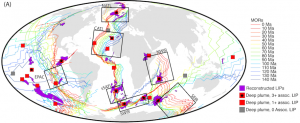 Citation
Citation
Whittaker, J. M., Afonso, J. C., Masterton, S., Müller, R. D., Wessel, P., Williams, S. E., & Seton, M. (2015). Long-term interaction between mid-ocean ridges and mantle plumes. Nature Geoscience, 8(6), 479-483.
Summary
Plate tectonic motions are commonly considered to be driven by slab pull at subduction zones and ridge push at mid-ocean ridges, with motion punctuated by plumes of hot material rising from the lower mantle. Within this model, the geometry and location of mid-ocean ridges are considered to be independent of lower-mantle dynamics, such as deeply sourced plumes that produce voluminous lava eruptions-termed large igneous provinces. Here we use a global plate model to reconstruct the locations of large igneous provinces relative to plumes and mid-ocean ridges at the time they formed. We find that large igneous provinces repeatedly formed at specific locations where mid-ocean ridges and plumes interact. We calculate how much mantle material was converted to oceanic lithosphere at the mid-ocean ridges and find that slowly migrating ridge systems that have been stabilized by upwelling plumes have extracted large volumes of material from the same part of the upper mantle over periods up to 180 million years. The geochemical signatures of mid-ocean ridge basalts and seismic tomographic data show that upper-mantle temperatures are elevated at significant distances from ridge-plume interactions, indicating a far-field, indirect influence of plume-ridge interactions on the upper-mantle structure. We conclude that strong feedbacks exist between the dynamics of slowly migrating ridges and deeply sourced plumes.
Downloads
Long-term interaction between mid-ocean ridges and mantle plumes
Download the supplementary files and data – zip file
Contact
Any questions, please email: jo.whittaker@utas.edu.au
![]()
